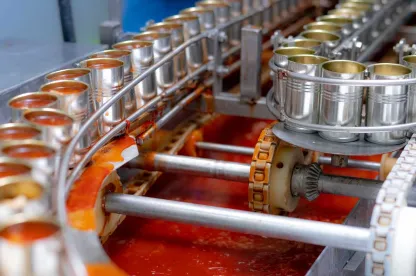After formulating an exciting new healthy food or beverage, the packaging it comes in may feel like an afterthought. It should not be. Food packaging has become an increasingly hot topic among federal and state regulators, as reports that chemical substances used in packaging materials may migrate to food continue to emerge. In addition, continued sustainability efforts—particularly at the state level—have resulted in laws that mandate food packaging be made from recycled content. This article examines the regulatory landscape governing food packaging and focuses on potential pitfalls.
Food Contact Articles
The United States Food and Drug Administration (“FDA”) regulates materials in contact with food (e.g., food packaging, bottles, containers etc.) and the substances from which they are made under the Federal Food, Drug, and Cosmetic Act (“FDCA”). These materials, previously called “indirect food additives,” are now referred to by the FDA as “food contact substances.” The FDA definition includes “any substance that is intended for use as a component of materials used in manufacturing, packing, packaging, transporting, or holding food if such use is not intended to have any technical effect in such food.” The broad definition encompasses polymers (e.g., plastic packaging materials), pigments and antioxidants used in polymers, adhesives, materials used in manufacturing paper and paperboard, antimicrobial agents, and sealants for lids and caps.
The regulatory status of a food contact article is determined by each food contact substance in the article. If a food contact substance used may reasonably be expected to migrate into the food, or otherwise affect the characteristic of food, then it generally must be covered by one of the following FDA requirements:
- A regulation in Title 21 of the Code of Federal Regulations;
- Meeting the criteria for status as Generally Recognized as Safe (“GRAS”) (including, but not limited to, a GRAS regulation or GRAS notice);
- A Threshold of Regulation (TOR) exemption request; or
- An effective Food Contact Substance Notification (FCN).
Confirming the regulatory status of food packaging can be a challenging task. Some, but not all, packaging suppliers provide information about the suitability of packaging materials for use as food contact materials. Some suppliers will guarantee or contractually commit to the suitability of their materials for food packaging. Regardless, the food product producer is ultimately responsible for ensuring that its food packaging materials comply with all legal requirements. This burden is challenging because individual states have enacted laws that ban or limit the presence of certain substances of concern in food packaging. We discuss several of these key efforts below.
Laws Limiting PFAS
Manmade chemicals called per- and polyfluoroalkyl substances (PFAS) are increasingly drawing the focus of federal and state regulators. PFAS provide heat resistance and non-stick properties, so they have been used in food packaging for many years. However, studies demonstrating potential adverse health effects associated with certain PFAS led to a push to remove them from packaging materials.
At the federal level, the FDA has authorized the use of certain PFAS materials as FCNs for paper and paperboard food packaging materials. Recently, however, the FDA began to pare back this authorization as studies on these chemicals continue to develop. For example, in 2016, the FDA revoked regulations authorizing the use of certain PFAS (so-called “long chain” compounds) for food contact applications, and as recently as February 2024, announced that U.S. manufacturers are no longer selling certain substances containing particular PFAS for use as grease-proofing agents on food-contact paper and paperboard. Many states moved more quickly than the federal government on PFAS, with some enacting more comprehensive bans against the use of PFAS as an entire class of chemicals for use as food contact materials. Although these legislative initiatives are still only effective (or under consideration) in a minority of states, states with considerable market power, such as California and New York, are among the first to pass new PFAS regulations.
Further, a growing number of consumer class action plaintiffs are filing lawsuits against food and beverage manufacturers alleging that PFAS in food packaging violates state consumer protection laws. Risks to food manufacturers from developing PFAS litigation will be explored in an upcoming article in this series, so stay tuned!
Post-Consumer Recycling (PCR) Content Laws
Legislation enacted in recent years by some states requires some packaging to be made from post-consumer recycled (PCR) content. These laws require producers (generally the brand owner, although there are individual state law nuances) to register with the state agency administering the program and annually report on compliance with the PCR requirements to the state regulatory agency. Food package materials typically impacted include glass bottles, wine and milk containers, and rigid plastic containers (i.e., those with an inflexible shape). Some of the legislative schemes exempt certain foods and beverages, but the laws and exemptions are not uniform across states. Compliance with these laws requires a state-by-state and product-by-product approach and understanding.
As with laws regulating PFAS, a minority of states have passed PCR content laws. Even so, the practical implications are significant for companies seeking a national product market. Most companies will find it impractical to select different packaging suppliers for use in certain regions of the country. State laws that limit a substance in packaging (like PFAS content laws) or mandate that packaging be made of certain materials (like PCR content laws) end up being the de facto compliance standard for many food and beverage companies.
“Green” Packaging Claims
Once an emerging company clears the wide range of potentially applicable food packaging laws, it is not necessarily done with legal analysis—at least not if its products include any statements about the recyclability or “greenness” of its packaging. Compliance on this issue is often of concern to consumers of products in the healthy food space, so companies in the area are well-served to understand the legal landscape. The Federal Trade Commission, for example, regulates recycling and other “green” claims via its so-called “Green Guides,” published in the Code of Federal Regulations. The Green Guides make clear that products are deceptive if they misrepresent that a package is made of recycled content or is recyclable. The Green Guides clarify when a company may make unqualified claims about recycled content and recyclability— including using the familiar “chasing arrows” symbol—and when these claims must be qualified. Consumer class action attorneys police this area and routinely assert claims under state consumer protection laws for not only recycled content and recyclability claims, but also claims relating to the compostable and/or biodegradable nature of food packaging.
The choice of packaging for your food or beverage product— and any claims you make about it— is as important to your company and brand as the choices you make about what goes into the product itself, so it pays to plan ahead.






 />i
/>i
